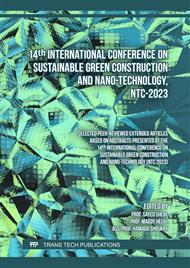p.1
p.15
p.25
p.37
Behavior of Reinforced Concrete Beams Strengthened in Negative Moment Region Using CFRP Plates
Abstract:
One possible method for strengthening deteriorated concrete structures is to externally bond composite material plates to the concrete. The use of Carbon Fiber Reinforced Polymer (CFRP) laminates as an effective and versatile technique for strengthening reinforced concrete (RC) structures has developed into a sizable industry in recent years. To implement such rehabilitation, the nature of the bond between the composite plate and the concrete must be understood. The behavior of reinforced concrete beams strengthened in the negative moment region using CFRP strips is presented in this paper. The experimental program included strengthening and testing five half-scale, reinforced, simply supported rectangular cross section beams with an overhanging (cantilever) portion. One of the tested specimens was tested without any strengthening and considered as the control specimen. The rest specimens were strengthened with CFRP strips using different technique and then tested until complete failure. The effect of strengthening technique on deflection, failure load, strain, failure mode, and ductility are discussed. In addition, and due to local stress concentration at the plate ends, the influence of different type of CFRP fixation at both ends for proper bonding of the strips, and the strengthening pattern on the behavior of beams was examined. The ratio of absorbed energy at failure to total energy, or energy ratio, was used as a measure of beam ductility. The results generally indicate that the flexural strength of the strengthened beams is increased. It is also noted that, in addition to the longitudinal CFRP plates, the fiber oriented in the vertical direction forming a C or U-shape around the beam cross section significantly reduce beam deflections and increase beam load carrying capacity. However, all the strengthened beams experienced semi brittle failure, mandating a higher factor of safety in design. The results also indicate that plating reduced crack size in the beams and somewhat reduced their ductility.
Info:
Periodical:
Pages:
1-14
Citation:
Online since:
June 2023
Authors:
Keywords:
Price:
Сopyright:
© 2023 Trans Tech Publications Ltd. All Rights Reserved
Share:
Citation:



